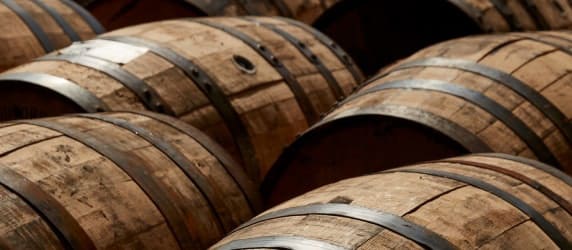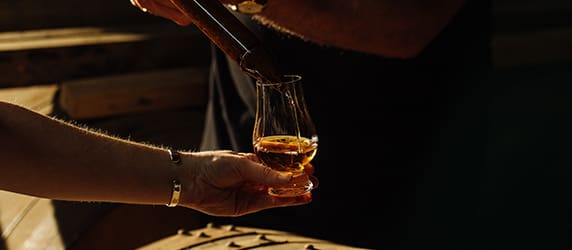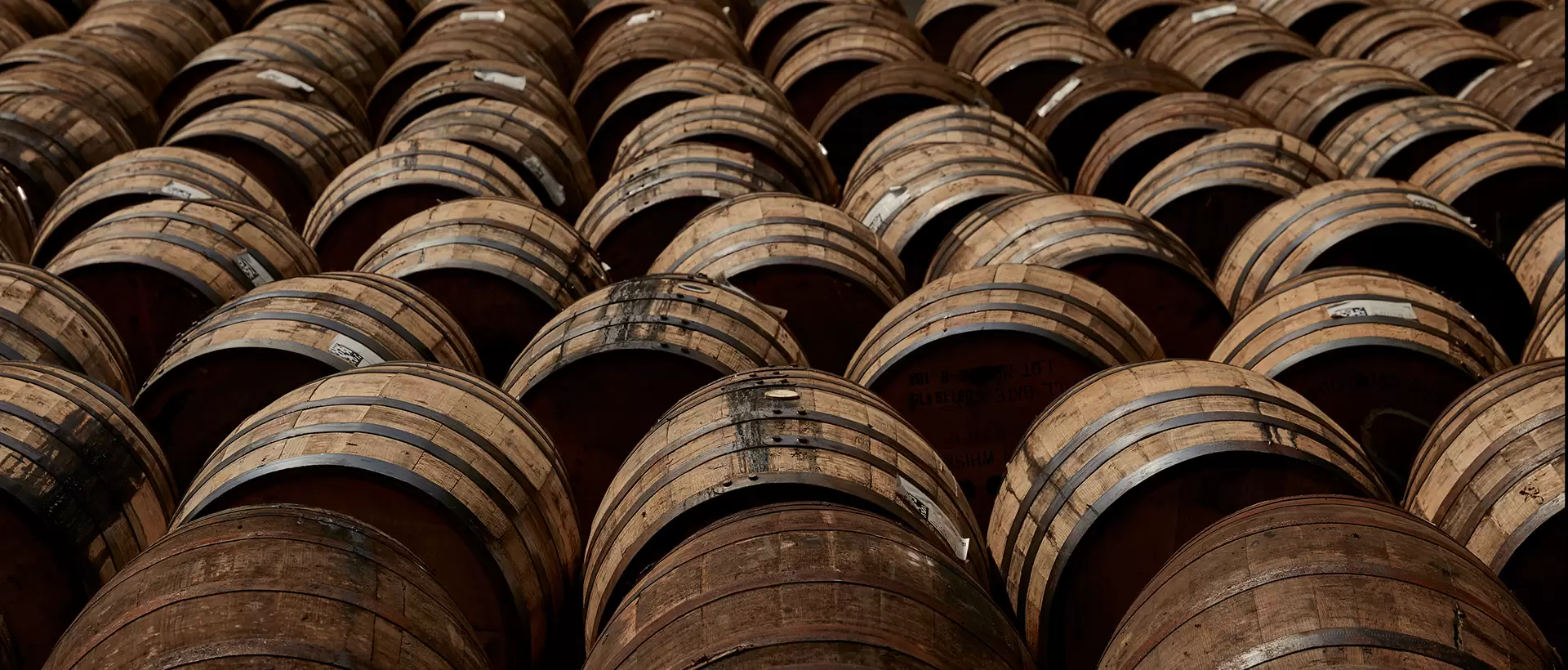Small Casks
We’re often asked why we don’t mature our whisky in quarter casks (125 litres), octaves (50 litres), and firkins or blood tubs (~30-40 litres). (200 litre ex-bourbon barrels are the smallest casks we fill at Annandale Distillery.)
To address this question, we need to consider the role of oak in whisky maturation:
Oak adds to maturing whisky as well as taking something from it. If the cask has previously held bourbon, Scotch whisky, sherry, wine, port, rum, cognac, etc., some of this maturing liquid will have become impregnated in the staves (staves are narrow lengths of wood with chamfered edges that form the body of a wooden cask). This liquid remains, impregnated in the stave after the cask is emptied. When new-make spirit is filled into the emptied cask, some of the previous occupant will be extracted from the staves, adding flavour and colour to the maturing liquid, often quite quickly.
The maturing spirit also extracts various naturally compounds from the oak, including vanillin (vanilla/sweet/confectionery flavour), tannin (astringency and golden brown colour – as in black tea) and various sugars (principally xylose but also arabinose, galactose, ribose rhamnose and glucose).
Whisky casks are usually charred inside. Charring has a three-fold effect:
1.) It produces a layer of carbon on the inner surface of the stave. Carbon is very porous, which allows it to adsorb (as opposed to absorb) various compounds from the maturing spirit. Some of these adsorbed substances may be undesirable flavour and odour compounds.
2.) It increases the porosity of the surface of the stave which encourages deeper penetration of the spirit into the oak.
3.) It induces chemical reactions in the oak that are implicated in the conversion of hemicellulose (one of the principal structural components of oak) into the aforementioned sugars (although glucose arises from elsewhere).
The sum total of all of these effects is known as ‘cask effect’ (or sometimes ‘oak effect’).
Probably the most important consideration when choosing casks for whisky maturation, is the extent to which the distiller wishes the flavour of the final whisky to be influenced by cask effect. The nature and extent of the cask effect depends on three factors:
The ‘freshness’ of the oak (i.e. how often the cask has been filled previously and for how long). The fresher the oak, the greater its potency in terms of delivering vanillin, tannin, xylose and other oak components.
The nature of the previous occupant(s). Sherry is likely to have a fairly potent effect. However, if the previous occupant had been Scotch whisky, the impact would typically be much less.
The ratio of the inner surface area of the cask to the volume of liquid held within the cask. The smaller the cask, the greater the ratio of the inner surface area of oak to volume of liquid inside, as shown in the bottom row of the table below. The smaller this ratio, the bigger the cask effect.
Firkin – Volume/litre 40 | Surface area/square metre 0.82 | Volume/square metre (litre) 48.8
Barrel – Volume/litre 200 | Surface area/square metre 2.23 | Volume/square metre (litre) 89.7
Hogshead – Volume/litre 250 | Surface area/square metre 2.59 | Volume/square metre (litre) 96.5
Sherry Butt – Volume/litre 500 | Surface area/square metre 4.03 | Volume/square metre (litre) 124.1
By way of example, a 40 litre firkin has the equivalent of 48.8 litres of spirit per square metre of inner cask surface area (i.e. a ratio of ~50:1) whereas, with a 200 litre barrel, it’s 89.7 litres/square metre (~90:1). In other words, there’s much more oak contact in a firkin than in a barrel (x 1.84) and therefore the ‘cask effect’ is likely to be bigger. The difference between a barrel and a sherry butt is also considerable (89.7 versus 124.1 litres/square metre, respectively). There’s even a noteworthy difference between a barrel and a hogshead.
Make no mistake, cask effect is often used quite deliberately, as means of expeditiously bringing Scotch whisky to an acceptable level of sensory maturity, at an early age. There’s nothing wrong with this as such (in my opinion) provided the resulting whisky remains within the boundaries of what is an acceptable/credible Single Malt Scotch Whisky and provided the defining character of the distillery’s spirit is still evident. (These are the criteria applied at Annandale Distillery). However, it’s totally unacceptable if some sort of cask effect (e.g. ‘finished in Madeira wood’) is presented as an intriguing adjunct, when the real reason is to mask bad, imbalanced, rough or otherwise immature spirit. Sadly, this happens. I’m always very suspicious when multiple cask effects are used to finish a whisky, especially a young whisky.
Amongst purists, there’s even a point of view that once-used ex-bourbon barrels (i.e. barrels that have only been used once to mature bourbon) exert too much cask effect on the flavour of the whisky. Whilst this point of view may be a little extreme, it’s certainly possible to ‘over bourbon’ Scotch whisky (again, in my opinion).
To summarise, at one end of the spectrum, the most benign maturation vessel for Scotch whisky (i.e. with minimum cask effect) would be a several-times-used ex-bourbon cask (ideally of known provenance). The whisky may take longer to mature but the intrinsic character of the distillery’s spirit will surely shine through (warts and all). During the first three years of production, Annandale Distillery laid down ~50% of its stock in several-times-used ex-bourbon casks with a view to longer-term maturation. The other end of the cask effect spectrum would be represented by a never-used-before, 40 – 50 litre cask made from virgin Spanish oak and conditioned for two years with either oloroso of Pedro Ximinez sherry. In this case, it’s entirely possible that the maturing spirit will be ‘over-oaked’ (i.e. excessive cask effect) before reaching the legal 3 year minimum, and any evidence of distillery character will have been overwhelmed.
At Annandale Distillery, we’re entirely confident in the quality of our new-make spirit*, so we don’t want to (and we don’t need to) obliterate its intrinsic character using excessive cask effect. That’s why we don’t mature our whisky in small casks.
(*We’re so confident about the quality of our new make spirit that we bottle it at 63.5% ABV and sell it as Rascally Liquor®. Why not give it a try?)





